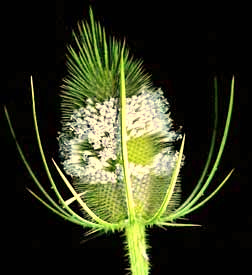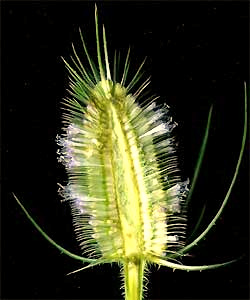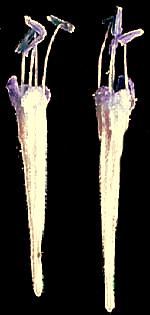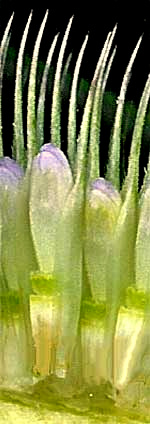
When you look at the teasel head at the right, you may think it couldn't be anything other than a member of the Aster or Composite Family, the Asteraceae, because it's so similar to a thistle head in that family. What else could it be with so many tiny flowers in a head with those spiny projections below the head, like the spiny involucre of a thistle? Below, a teasel head is broken apart to better show how the many tiny flowers cover a kind of platform surface, just as many tiny, black disc flowers of an Aster-Family Black-eyed Susan arise from the flowering head's tall, Aster-Family receptacle.

But, teasels aren't members of the huge Aster Family. The teasel's flowering heads and flowers are so unusual that traditionally the 15 or so teasel species, genus Dipsacus, have been assigned to their own family. Nowadays, recent genetic analysis has abolished the Teasel Family, and discovers teasels to belong to the Honeysuckle Family, the Caprifoliaceae.

Well, maybe so, once you look at the teasel's individual flowers, shown at the right. Like honeysuckle flowers, teasel flowers have long, slender, tubular corollas, plus they're slightly asymmetrical (bilaterally, one side mirroring the other) while honeysuckle flowers are strongly bilaterally symmetrical. Flowers of honeysuckle species usually bear five stamens, but sometimes four, while teasel flowers have four. And both honeysuckle and teasel plants bear their leaves opposite one another on the stem.
Moreover, remember that honeysuckles appear in twos, so there's an urge in the family to cram flowers together. Plus, remember that pairs of honeysuckle flowers are surrounded at their bases by two leaves grown together in a special way, so there's also an urge in the family to produce flowering heads with a kind of collar below them.

Still, when at the left you see the how individual teasel flowers in the flowering head are accompanied by stiff, needle-tipped, scale-like things that partially wrap around the flowers' bases -- just like paleae in many Aster-Family species -- you just have to wonder at the many similarities between teasels and the Aster Family.
Well, the enormous Aster Family clearly has stumbled upon a very successful strategy for survival by placing many small florets in large, flower-like heads, so maybe the Honeysuckle with its teasels is making a kind of independent discovery of the same trick. Maybe there's some convergent evolution going on here. On the phylogenetic Tree of Life, the two families occupy the same general part of the tree, along with the Parsley Family, the Umbellifereae, which also tends toward flower-head making.
Maybe in this way Nature teaches that in this life anyone can take a good idea and develop it his or her own way.